- In which Marcia relates the saga of the raspberry bed -
 Once upon a time (say, mid-2010), Marcia's friend Eleanor mentioned that she loved fresh raspberries, and wondered if there might be some place in the yard where a few raspberry plants could be tucked in? Marcia though adding raspberries was a great idea! It would make her friend Eleanor happy, and there would be tasty raspberries to eat.
Once upon a time (say, mid-2010), Marcia's friend Eleanor mentioned that she loved fresh raspberries, and wondered if there might be some place in the yard where a few raspberry plants could be tucked in? Marcia though adding raspberries was a great idea! It would make her friend Eleanor happy, and there would be tasty raspberries to eat.
Where to put them? The more sun, the better, for most fruit-bearing plants. And some support for tying up the canes would be good. So a spot was chosen along the fence on the side of the house, next to the grape vines.
Now, I will plant no vine before it's time. I'm a firm believer in double-digging and adding the proper soil amendments for a location where a plant will be in place for a long time. I started excavating in May 2010.
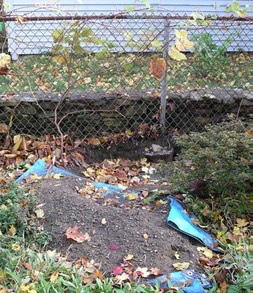 But I got sidetracked by various things, and by the time winter came around, I'd only gotten halfway through bed preparation.
But I got sidetracked by various things, and by the time winter came around, I'd only gotten halfway through bed preparation.
Winter came and went, and spring 2011 arrived. Once the ground thawed out, digging recommenced.
In the spring, when the ground warms up and the scents of earth coming back to life hit my nose, it seems to go right to my hindbrain, and I am overcome with the desire to start digging like a madbeast.
In May 2011, I finished excavating the top layer, then started digging through the lower layer, removing broken cement, old bricks, rocks, old nails, etc as I went.
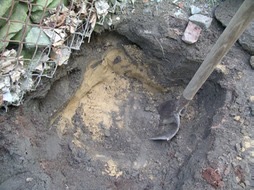
I kept my measuring tape handy so I could determine how far down I'd gotten.
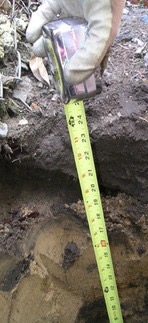
There was so much rock and gravel mixed in with the soil that I eventually ordered a garden sieve. I wound up shoveling all the dirt out of the hole (even the bottom layer), and then sifting it back in. Madness, perhaps. But it resulted in wonderful, fluffy soil with no gravel in it.
Once all the stuff I didn't want was out of the soil, it was time to put in some of the stuff I *did* want. Since our soil here in Salem, Massachusetts is very sandy, I added about 2" of shredded cocoa fiber (coir) for organic material. I also added a sprinkling of organic, slow-release fertilized, and I tossed on some polymer crystals for water retention. And after tossing those things on the top of the bed, I ran out of time and energy, so I went in for the day and figured I'd mix in the additives the next day. Then it rained.
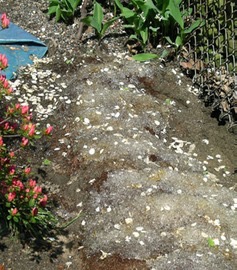 Here's what the polymer crystals look like after a rain, if they're just sitting on top of the soil. Sort of reminds me of frog spawn somehow.
Here's what the polymer crystals look like after a rain, if they're just sitting on top of the soil. Sort of reminds me of frog spawn somehow.
When things dried out enough, I finished mixing everything in.
The bed looked great!
Was it done? Um, no. At that point I remembered that raspberries have a bad habit of "running". I read a tip about lining the bed with 20" of metal flashing. Sounded like a good idea (remember, this is the Cadillac of raspberry beds I'm making here!), so I went out to my local hardware store and looked for 20" flashing, but no luck. So I hopped on the internet, and ordered a roll of flashing. And drummed my fingers until it showed up.
Onward!
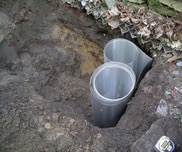
First, at one end I've got to excavate (*again*) down to a depth of 20" (plus a little bit) to get the roll of flashing into position. Did that, wrassled the roll into place. Even for light aluminum sheeting, when there's a bunch of it rolled together it's kind of heavy. I folded a nice corner before I put it in place.
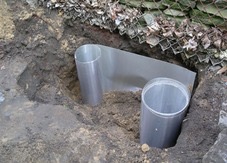
Then to dig out soil in front as I unroll it, and put soil back in place behind as I go along.
So far, so good.
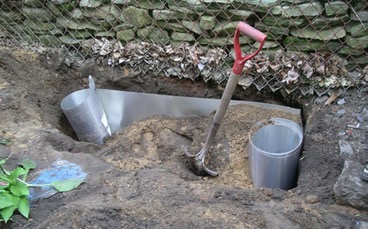
It's a bit tedious, but it goes steadily along.
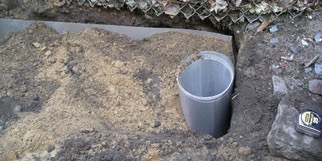
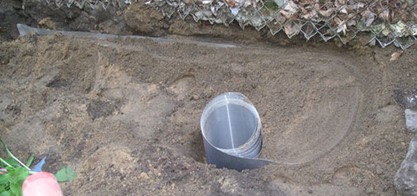
Once the soil is backfilled, the lining can hardly be seen.
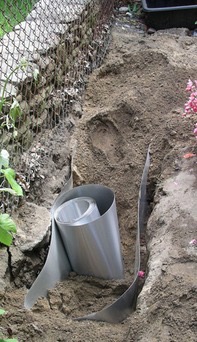
Now I've made it all the way down to the other end of the bed. My nice straight lines and crisp corners are getting a little more casual, and I'm finding that keeping the top edge of the flashing level is not as easy as it looks. But it's close enough, once I get things straightened out a little.
At this point, it suddenly occurs to me that I have no idea how I'm going to cut the aluminum metal sheet, now that I've worked my way all around the edge of the bed.
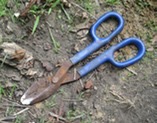
Aha! Eleanor dredges up an old pair of tinsnips. Whew. The cut edge isn't very straight, and it isn't very pretty, but that doesn't matter because the whole thing is out of sight anyhow.
[For planting, go to Part 2 of this saga.]